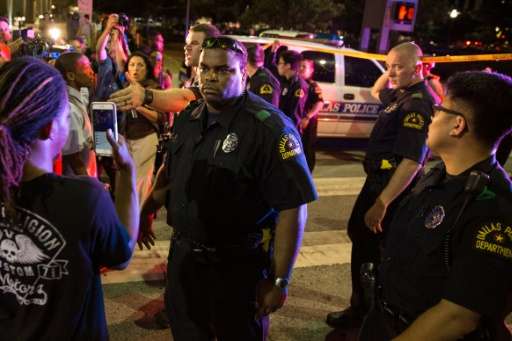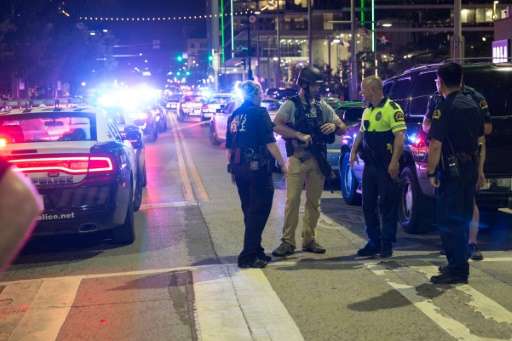Police attempt to calm the crowd as someone is arrested following the sniper shooting in Dallas on July 7, 2016
The "bomb robot" killing of a suspected Dallas shooter may be the first lethal use of an automated device by American police, and underscores growing role of technology in law enforcement.
City police chief David Brown told reporters Friday that officials "saw no other option but to use our bomb robot" to detonate to avoid any further danger after sniper fire killed five Dallas officers.
It was not immediately clear what kind of device was used in Dallas, but it was widely believed to be the first time a robot was deployed in such a manner by US law enforcement.
"Yes, this is 1st use of robot in this way in policing," said a tweet from New America Foundation fellow Peter Singer, who heads a technology advisory firm and has written on 21st century warfare.
Singer noted that one device known as the Marcbot "has been ad hoc used this way by troops in Iraq."
Matt Blaze, a University of Pennsylvania professor of computer and information science, said on Twitter it was probable that "the bomb delivery robot was an improvised arrangement, not something it was designed for."
Still, Blaze tweeted that "stakes go *way* up when something like this is repurposed as a weapon."
Regardless of the methods in Dallas, the use of robots is expected to grow, to handle potentially dangerous missions in law enforcement and the military.
One robot developed by China's National Defense University called AnBot has been designed for "an important role in enhancing the country's anti-terrorism and anti-riot measures," according to its website.
According to a Popular Science article authored by Singer with Jeffrey Lin, AnBot is among several machines designed for police patroling.
Police stand near a baracade following the sniper shooting in Dallas on Thursday, July 7, 2016
"Anbot's most controversial feature is naturally the onboard 'electrically charged riot control tool; (likely a Taser or extendable cattle prod). This can only be fired by the Anbot's human remote operators," they wrote in the April article.
"The Anbot's large size means that it has room to mount other law enforcement gear, like tear gas canisters and other less lethal weaponry."
Another robot developed by California startup Knightscope uses "advanced anomaly detection," and according to the website TechCrunch is being used to augment security at some Silicon Valley tech firms and a shopping mall.
RoboCop redux?
Researchers at Florida International University meanwhile have been working on a TeleBot that would allow disabled police officers to control a humanoid robot.
The robot, described in some reports as similar to the "RoboCop" in films from 1987 and 2014, was designed "to look intimidating and authoritative enough for citizens to obey the commands," but with a "friendly appearance" that makes it "approachable to citizens of all ages," according to a research paper.
Robot developers downplay the potential for the use of automated lethal force by the devices, but some analysts say debate on this is needed, both for policing and the military.
A 2014 report by Human Rights Watch and Harvard Law School's International Human Rights Clinic raised concerns about the use of fully autonomous weapons in law enforcement operations.
"They could not be preprogrammed to handle all law enforcement scenarios," the report said.
"And they would lack human qualities, such as judgment and empathy, that enable police to avoid unlawful arbitrary killings in unforeseen situations."
© 2016 AFP























